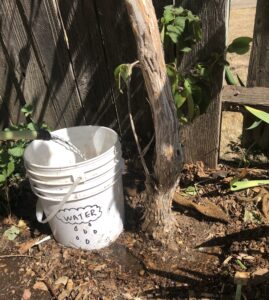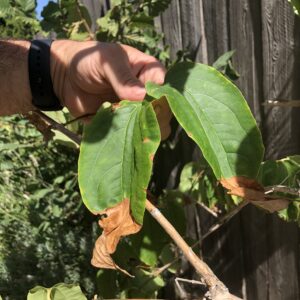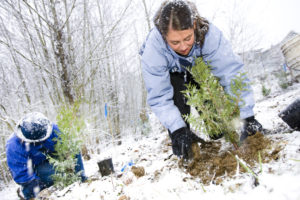Category: Nature
Simple ways to protect your tree on windy days
The Pacific Northwest is experiencing a historic windstorm event in September, 2020. These winds can cause serious damage to both young and established trees. When the winds pick up, you can take some simple steps to prevent damage to your tree friend.
What should I do to protect my trees from wind?

Wind causes leaves to dry out more quickly. That’s why it’s important to make sure tree roots have access to water in the soil to replenish the water lost through their leaves. If trees don’t have enough access to water in the soil, the leaves can dry out, and potentially cause dieback.
- Newly planted trees (1-5 years since planting): Make sure to give young trees a nice, deep soaking of the root zone with about 10-15 gallons of water. That’s three large buckets of water, slowly added to the soil. Make sure you soak all of the soil within two feet of the trunk, and imagine you are trying to reach the roots about a foot deep in the soil.
- Established trees (5+ years): This is a great job for a soaker hose or sprinkler, slowly moistening the soil around the edge of the canopy of the tree. Some mature trees are already experiencing drought stress, so it’s extra important to give them an extra drink during windy periods.

Why does my tree lose water through its leaves?
Water loss through leaves is due to a process called transpiration, which is essentially the process that occurs after your tree takes up water from the soil, uses it for photosynthesis, and then releases it back into the air. The US Geological Survey explains it this way:
“The typical plant, including any found in a landscape, absorbs water from the soil through its roots. That water is then used for metabolic and physiologic functions. The water eventually is released to the atmosphere as vapor via the plant’s stomata — tiny, closeable, pore-like structures on the surfaces of leaves.”
That water (H2O), of course, plays an important role in photosynthesis while inside the plant, reacting with carbon dioxide (CO2) to produce some delicious sugars for the plant to eat (C6H12O6) and some complimentary fresh oxygen (O2) for us!
So, why does the wind cause tree leaves to dry out more quickly?
Because water likes to distribute itself evenly, it will tend to move from a moist location to a drier location. If the inside of the leaf is moist, and the outside air is also moist, water won’t feel the need to jump ship.
But, as Wikipedia explains, “wind blows away much of this water vapor near the leaf surface…speeding up the diffusion of water molecules into the surrounding air.” The wind moves the moisture away from the leaf, encouraging more water to exit the leaf and re-moisten the surrounding air.
So, keep an eye out for dry/windy weather in the forecast, and make sure your trees and plants are prepared. And give special attention to evergreens in windy/dry periods during the winter, as these trees with year-round leaves and needles will transpire year-round as well.
Tree walks & tree talks for you
It’s the 50th anniversary of Earth Day this year. Friends of Trees was planning to celebrate in our usual fashion: Planting trees. Together. But, like everyone, our plans changed.
We would, of course, prefer to be outside with you. But since we can’t we have some really special virtual tree treats for you.
Since trees and nature can be so comforting, the Friends of Trees staff contributed to Earth Day with some homemade tree talk videos; we’re hoping these will tide you over until we can plant trees with you again. Below is a selection of our work, you can find the entire playlist here (we’ll be adding more, so check back!).
We need to do something bigger than ourselves.
“We need to do something bigger than ourselves.”
– Mohamed, Friends of Trees volunteer since 2014
Mohamed and his wife Farah, and their children and friends, have planted hundreds of trees with us in memory of their daughter, Ayan. Farah very candidly shares why, “Every tree that we plant I feel like it’s for her. And I think about all of the benefits that all these trees will produce … it keeps on giving. It’s a way of sharing her with the world.”
This beautiful video shares the story about why Mohamed, Farah, and their family plant trees together in honor of Ayan:
“When you are outdoors and in nature you tend to forget whatever problems you may have. When you go into nature with others and look at the beauty, how big things are … it has that healing process.” -Mohamed
The more than 50,000 trees and shrubs we plant every year with so many community volunteers transform neighborhoods and natural areas. Trees clean our air and water, cool the planet, provide habitat—and can help us feel better. There are many examples of how trees improve our health; just the act of planting a tree can be personally transformative; digging in the dirt with the hope and intent of something taking root just feels good.
It’s about trees and it’s about community. When we come together to plant trees we are doing something good, we’re making a difference and we’re making our world a better, more welcoming place.
There is so much we can do that is bigger than ourselves. Donating to Friends of Trees’ programs that plant trees and grow community will help our planet and its inhabitants for generations to come. As Mohamed also shared, “Planting trees really will outlive us. The effort that you put is so small, the benefit is just gigantic.”
Thank you for the gigantic act of supporting trees + community. We look forward to planting trees with you!
Give the gift that fights climate change
 Surprise your friend or loved one this holiday season with a gift that will grow over time, improve local natural areas, and clean our air & water!
Surprise your friend or loved one this holiday season with a gift that will grow over time, improve local natural areas, and clean our air & water!
Gift Trees are a lasting legacy that honor or remember loved ones while improving our environment. All Gift Trees are planted through our Green Space Program, which restores sensitive natural areas in our region. And with Friends of Trees, Gift Tree purchasers and recipients have the option to plant their Gift Tree. However, if you cannot attend a Gift Trees planting event we will make sure your Gift Tree gets planted.
For each Gift Tree (or grove of 6 trees), you will be able to choose a certificate you can customize with your recipient’s name and print at home.
You and your gift recipient can join Friends of Trees to plant the tree, if you wish, during one of our Gift Tree planting events during the coming year—or we can plant it for you. Gift Tree FAQs
Please note: The deadline has passed if you’d like to have a paper certificate mailed to you in time for Christmas giving; however, if you’re in a crunch, please email Kathy directly and we’ll try to make it happen. Remember, you can order a Gift Tree and print your own certificate at any time. Donate to order your Gift Tree here.
All Gift Trees support natural area restoration through Friends of Trees’ Green Space Program. Thank you for greening our world through your holiday giving!
Tree care – we do that too!

Congratulations, you helped plant 50,000 trees and native shrubs last season! Now what? Good thing Friends of Trees isn’t just a tree planting organization–tree care is also on the list because we want the trees we plant to survive and grow and thrive.
It works.The survival rate for urban trees planted the Friends of Trees way, together, with guided post-planting care from our Tree Team, is 97% (based on Portland street trees planted last season). For the subset of trees we’ve been monitoring for nine years since planting it’s an 88% survival rate.
Our trees planted in natural areas also have strong survival rates, especially given some very challenging conditions; for example, some planting sites are not accessible for watering; some plants get eaten by wildlife; humans sometimes trample or vandalize; etc. Some studies indicate that an acceptable minimum survival rate for riparian area restoration plantings is 50%, so our survival rates of 81% in year one and 70% after three years are particularly impressive.
How do we help trees thrive?
We water. We prune. We mulch. We visit and assess. We do this for the street and yard trees planted through our Neighborhood Trees program as well as for the native trees and shrubs planted in our Green Space program.
As part of our Neighborhood Trees post-planting care, we:
- continually share information with tree-recipients about how much water, mulch and pruning trees need;
- deliver and apply free mulch soon after trees are planted;
- offer a summer watering service for a reasonable fee;
- have a Summer Inspector program where trained volunteers visit all newly planted trees twice in the first summer after planting to inspect for tree health, leaving tree care info for the tree recipient.
- have a longer term monitoring program where we visit subsets of trees planted anywhere from two to 10 years ago, to track health and growth;
- prune trees throughout the year (except for a few weeks in the spring and fall when trees are budding or dropping leaves). We rotate neighborhoods each year and focus most of our work on low income, low canopy and/or historically under-served communities.
Did we mention we prune? Last season we pruned more than 1,600 street trees, which is vital toward proper growth and really helps them survive wind, snow, and ice storms.
Our Green Space program also cares for the new trees and shrubs planted in natural areas, and we do this for up to 10 years after planting. The team is often joined by employee volunteer groups who help with summer maintenance tasks such as watering, mulching, and weeding (also called “day-lighting” since we’re clearing space around new plantings to provide for more light and air, and to reduce competition with weeds). We also assess for survival and replant when necessary.
Volunteers help with this! We train volunteers to inspect and prune trees, and volunteers are crucial to effectively mulching thousands of new trees at tree care events.
All told, we care for and monitor more than 54,000 trees a year!
We’re spreading the good word about trees.
We spend much of the summer spreading the word. Our Volunteer & Outreach Team, aided by dedicated Tree Team Ambassadors, attend events, festivals and fairs; plus, we have a crew of Canvassers who go door to door in priority neighborhoods. We strive to reach historically under-served, low-canopy neighborhoods with information about how to volunteer with us and how to get a tree from us. Interested in being a part of this? We’d love for you to join us.


 Surprise your friend or loved one this holiday season with a gift that will grow over time, improve local natural areas, and clean our air & water!
Surprise your friend or loved one this holiday season with a gift that will grow over time, improve local natural areas, and clean our air & water!